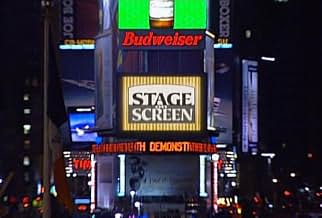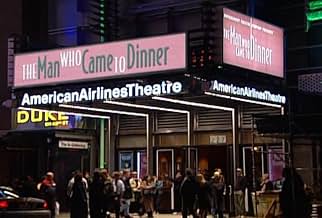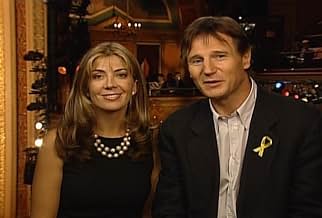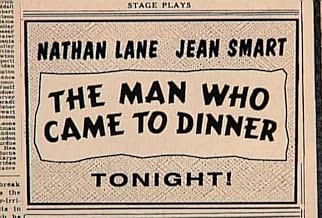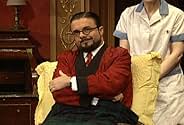Adicionar um enredo no seu idiomaCantankerous theatre critic Sheridan Whiteside falls on an icy sidewalk, breaks his hip, and is temporarily stranded at the Ohio home of Richard Stanley and his family. While he's there, Whi... Ler tudoCantankerous theatre critic Sheridan Whiteside falls on an icy sidewalk, breaks his hip, and is temporarily stranded at the Ohio home of Richard Stanley and his family. While he's there, Whiteside turns life upside-down for everyone.Cantankerous theatre critic Sheridan Whiteside falls on an icy sidewalk, breaks his hip, and is temporarily stranded at the Ohio home of Richard Stanley and his family. While he's there, Whiteside turns life upside-down for everyone.
- Direção
- Roteiristas
- Artistas
Harriet Sansom Harris
- Maggie Cutler
- (as Harriet Harris)
Jeff Hayenga
- John
- (as Jeffrey Hayenga)
- Direção
- Roteiristas
- Elenco e equipe completos
- Produção, bilheteria e muito mais no IMDbPro
Avaliações em destaque
The 1942 film THE MAN WHO CAME TO DINNER was possibly the best comedy film that Bette Davis ever appeared in, but while she got starring position in the film's credits, the real star (who went to town as a result) was the great Monty Woolley, recreating his magnificent acid tongued curmudgeon Sheridan Whiteside. It was one of the rare occasions when a stage performance of importance was saved on film.
Fifty eight years later (forgetting one disastrous television version with Orson Welles as Whiteside in 1972) PBS showed this production of the stage revival of the play with Nathan Lane in the Whiteside role. Lane played the role perfectly, basing it (physically) closer to the original figure Whiteside is based on - writer, critic, actor, radio personality, and Algonquin Round Table Wit Alexander Woolcott. His facial appearance included wearing the round eye frame glasses that Woolcott wore all the time. Lane did not have the crusty, elderly asperity of the great Woolley, but he did have a malevolent elfin charm reminiscent of Woolcott (a man who was all too easy to dislike - Woolcott was also the model for Waldo Lydecker in LAURA, which just goes to show his popularity).
One of the problems with comedy (or drama generally speaking) is the fact that the works can be dated in their references. When, in one of his plays, Shakespeare refers to "the Great Sophy" it is to some long ago forgotten English traveler and diplomat named Shirley who went to Persia. Most of us see the foot note of this 16th Century reference and try to concentrate on the rest of the play that still is strong and relevant to us. But with THE MAN WHO CAME TO DINNER the great problem is the barrage of trivia that comes out of the play. Woolcott's two Algonquin friends (Kaufman and Moss Hart) added small bits of biography to his stage version, which everyone who knew Woolcott would recognize. The theater critic knew everyone of importance in the theater. So he has a scene with a clone of Noel Coward named Beverley Carlton (to add to perfecting the imitation of Coward, Kaufman and Hart asked Cole Porter, a close friend of Monty Woolley, to write a song for "Carlton" to sing to Whiteside, that was in Coward's distinct delicate style). The close friend of Whiteside who shows up as a comic "deus ex ma china" in the play is "Banjo." This was based on Woolcott's close Algonquin friend Harpo Marx.
But most of the references are quite arcane. Who is Elizabeth Sedley? Well, it is a reference to a celebrated murder case defendant, whose career would have intrigued Woolcott, the great amateur criminologist. What are the references to Beebe and Byrd? This version got around the problems using mock 1930s newspaper headlines chronicling William Beebe the oceanographer and Admiral Richard Byrd, the Polar explorer. This sounds cumbersome, but it was far more effective and useful to the viewers than the idiocy of the 1972 Welles' version where the script was "up-dated" meaninglessly.
The program was an excellent version of the classic comedy, and well worth comparing with the Woolley film. I feel that it deserves a "10".
Fifty eight years later (forgetting one disastrous television version with Orson Welles as Whiteside in 1972) PBS showed this production of the stage revival of the play with Nathan Lane in the Whiteside role. Lane played the role perfectly, basing it (physically) closer to the original figure Whiteside is based on - writer, critic, actor, radio personality, and Algonquin Round Table Wit Alexander Woolcott. His facial appearance included wearing the round eye frame glasses that Woolcott wore all the time. Lane did not have the crusty, elderly asperity of the great Woolley, but he did have a malevolent elfin charm reminiscent of Woolcott (a man who was all too easy to dislike - Woolcott was also the model for Waldo Lydecker in LAURA, which just goes to show his popularity).
One of the problems with comedy (or drama generally speaking) is the fact that the works can be dated in their references. When, in one of his plays, Shakespeare refers to "the Great Sophy" it is to some long ago forgotten English traveler and diplomat named Shirley who went to Persia. Most of us see the foot note of this 16th Century reference and try to concentrate on the rest of the play that still is strong and relevant to us. But with THE MAN WHO CAME TO DINNER the great problem is the barrage of trivia that comes out of the play. Woolcott's two Algonquin friends (Kaufman and Moss Hart) added small bits of biography to his stage version, which everyone who knew Woolcott would recognize. The theater critic knew everyone of importance in the theater. So he has a scene with a clone of Noel Coward named Beverley Carlton (to add to perfecting the imitation of Coward, Kaufman and Hart asked Cole Porter, a close friend of Monty Woolley, to write a song for "Carlton" to sing to Whiteside, that was in Coward's distinct delicate style). The close friend of Whiteside who shows up as a comic "deus ex ma china" in the play is "Banjo." This was based on Woolcott's close Algonquin friend Harpo Marx.
But most of the references are quite arcane. Who is Elizabeth Sedley? Well, it is a reference to a celebrated murder case defendant, whose career would have intrigued Woolcott, the great amateur criminologist. What are the references to Beebe and Byrd? This version got around the problems using mock 1930s newspaper headlines chronicling William Beebe the oceanographer and Admiral Richard Byrd, the Polar explorer. This sounds cumbersome, but it was far more effective and useful to the viewers than the idiocy of the 1972 Welles' version where the script was "up-dated" meaninglessly.
The program was an excellent version of the classic comedy, and well worth comparing with the Woolley film. I feel that it deserves a "10".
We were unable to get tickets for this show while in NYC on vacation this summer, so it was a pure delight to have live Broadway brought into our home! We can only hope for more productions of a similar nature!!
'The Man Who Came To Dinner' revival was just absolutely amazing! The cast shined. Mr.Sheridan Whiteside was played by the one and only Nathan Lane, who made the play pleasurable the whole time. Jean Smart was, in my opinion, one of the funniest on stage. In a specific scene, when she finds out her cables have been wrongfully sent, she has the crowds (and folks at home) up in roars. This wonderful cast also includes Lewis Stadlen, Harriet Harris, Byron Jennings, Terry Beaver, and many more. If you are ever faced with the chance to see this play, don't pass on it! It Is A True Masterpiece!!
As someone who goes out of his way to see performances of "The Man Who Came to Dinner"--one of the greatest comic concoctions of the 20th century--I thought this was the best media presentation of the play to date, much better than the 1940 film version. My only quibble concerns the decision to pattern Lewis Stadlen's Banjo after Jimmy Durante's version in the film, rather than Harpo Marx (upon whom the character was originally modelled), but that's a matter of personal taste. (And to be fair, Stadlen does just fine, perhaps even out-Duranting Durante.) Conversely, I can't imagine anyone better in the title role than Nathan Lane, and he lives up to my hopes splendidly. (I hope PBS broadcasts him in "The Producers" one of these days!)
I enjoyed the taped stage play setting and all of the characters were immediately familiar to me, having just viewed the 1942 version. I rarely miss anything that Nathan Lane does and thought him perfect casting as Sheridan Whiteside.
However...it all seemed a bit forced to me. Lane's delivery was good and his mugging very funny, but he was working all the time. It just didn't seem to come naturally. The "Banjo" character was just an impersonation of Durante and an average one at that. As with the '42 film, I feel this character was superfluous.
The overall impression for me was one of a very good amateur company doing their very best to put on a show. I never forgot it was a play, whereas in the '42 version, I got more involved in the story.
As for the inter-act comments from the host and hostess, I skipped those immediately (so grateful for DVD technology!). The newsreel footage and swing music were delightful between the acts, though.
However...it all seemed a bit forced to me. Lane's delivery was good and his mugging very funny, but he was working all the time. It just didn't seem to come naturally. The "Banjo" character was just an impersonation of Durante and an average one at that. As with the '42 film, I feel this character was superfluous.
The overall impression for me was one of a very good amateur company doing their very best to put on a show. I never forgot it was a play, whereas in the '42 version, I got more involved in the story.
As for the inter-act comments from the host and hostess, I skipped those immediately (so grateful for DVD technology!). The newsreel footage and swing music were delightful between the acts, though.
Você sabia?
- CuriosidadesThe part of Banjo was originally based on Alexander Woollcott's good friend, Harpo Marx. However, in this production, the character is blatantly patterned after Jimmy Durante, who played the role in the 1942 film adaptation.
- Citações
Sheridan Whiteside: I may vomit.
- ConexõesReferenced in My Boys: Free Agent (2006)
Principais escolhas
Faça login para avaliar e ver a lista de recomendações personalizadas
Detalhes
- Data de lançamento
- País de origem
- Idioma
- Locações de filme
- Nova Iorque, Nova Iorque, EUA(American Airlines Theater)
- Empresas de produção
- Consulte mais créditos da empresa na IMDbPro
Contribua para esta página
Sugerir uma alteração ou adicionar conteúdo ausente


